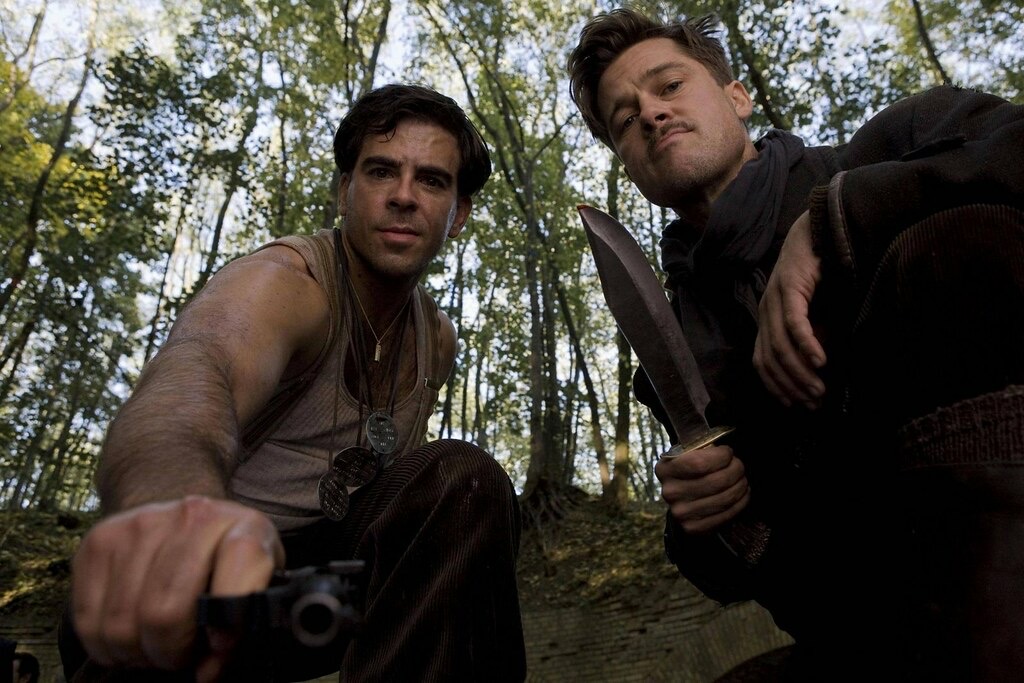
GUILLOTINE: Stop killing fictional Nazis

Nazi soldiers get a hard time in the movies. They’re Hollywood’s cartoon villains; from Indiana Jones to Inglorious Basterds, we love to watch those frankfurter eating fascists get blown to bits, battered with baseball bats, or, naturally, have their faces melted off. They’ve been written into everything from Marvel films to Cold War dramas. Taught blondes clad in Hugo Boss screaming at each other in funny accents just make wonderfully diabolical baddies.
And of course they’re our default antagonists. They’re the apotheosis of evil. The irredeemable scum of humanity that deserves to be endlessly beaten to a pulp by our strong-jawed heroes. Their ritualistic annihilation is supposed to be catharsis for the horrors of the Holocaust and the devastation of Europe, as well as a rebuke of their ideology of hatred. But let’s be honest, killing fictional Nazis is getting old.
It’s lazy writing. Why bother making your protagonists interesting or funny or likeable when you can just put their enemies in SS uniforms. They are place holders, something someone barely remembered about evil; moustache twirling villains with eccentric names and vague ‘foreign’ accents. But it matters far more than on a purely aesthetic level. They are a caricature that mocks history, and human life.
I should stop here to say what follows is not a defence of the Nazi party, or an attempt to equivocate the moral virtue of Nazi Germany to the British, or French, or American, or Soviet empires (yes, they were all empires, sue me). Comparing the atrocities of each power would be a pointless exercise. But, by writing out any moral grey area, posing the Second World War as a purification of evil, the good versus the bad, Western media whitewashes history to serve propaganda. It cheapens tragedy and promotes authoritarianism.
WWII movies are especially bad culprits for this, shock horror. WWII movies, I suspect, are organised by Hollywood’s propaganda department. I suspect because never before has so much money been spent to represent a conflict for the obvious purpose of glorifying the state. In them the death of Allied soldiers, though framed as a tragedy, is always portrayed as a necessary sacrifice in the mission to defeat the evils of fascism. Giving your life for the country is the most beautiful act of patriotism one could possibly muster. Unless you’re German, obviously. Who cares that they died, too, acting on orders from their governments to give their lives for their country?
And this is what brings me to Steven Spielberg, the bastard. A classic filmmaker, no doubt, the Oscar winner for Best Propaganda Piece at the 71st Military Academy Awards with Saving Private Ryan. Lauded not least for its famous opening sequence, the “most realistic” depiction of D-Day ever recorded. But we have actual footage of D-Day, and it looks nothing like what’s shown. The reason? The film captures emotion of D-Day. Spielberg became a master of manipulating the feeling of war, and exploiting it.
After the landing, the film follows a group of soldiers traversing occupied France in a brave quest to, uh, save Private Ryan. Throughout, one member of the troupe, Corporal Timothy Upham, finds himself embroiled in a number of moral dilemmas. Upham, unlike the rest of the crew, is not battle-hardened. He is a language interpreter who is pulled into the team out of pure necessity, a mumbling intellectual who never intended to see any real combat.
But it’s in his innocence that Spielberg and Co. find his folly. After an action sequence depicting them capturing a German bunker, Upham pleads with the rest of the team not to kill the one captive they take, reminding them to follow the rules of war. This angers the rest of the crew, who reluctantly back down from the war crime they were about to commit, but not after a few scoffs in Upham’s direction.
By the end of the film, Spielberg shakes off any interpretation of Saving Private Ryan as a caring emotional depiction of history’s deadliest conflict, instead transfiguring into its true form: a bloated action movie. EXPLOSIONS! GUNFIRE! DEAD FUCKING NAZIS! The film’s end is an orgy of violence. Bodies pile and blood pour in extremis. Fuck yeah! They’re killing the bad guys! Oh no! They killed one of the good guys! Let’s be sad about that! And so on, for about half an hour.
Re-enter Upham. As he scutters around the bombs and bodies he comes to the bottom of the stairs of a bombed-out house, where upstairs another member of the troupe, Private Mellish, is in a brutal fist fight with a German soldier. The courageous endurance of Mellish’s struggle is contrasted with Upham’s cowardly paralysis; he is unable to climb the stairs in time and his comrade is stabbed to death by the German. No dead Nazis, just dead Americans, and that’s really sad, obviously. The German descends the stairs, pushing past Upham and sneering at him with barbaric contempt. Upham’s impotence make him unworthy of even the solace of martyrdom.
Later, the German Upham freed at the bunker pops back up to strike a fatal blow to the film’s main protagonist, played by loveable audience favourite Tom Hanks. The message is clear: Upham’s refusal to engage in the purification ritual of violence directly leads to the deaths of two of our heroes. But what was the alternative? For Upham to kill two Germans? In the end, the result would have been the same: two lives would have been lost in the calamity of war. But remember, a life is worth more when it’s portrayed by an American movie star.
So what? The enraged Western patriot pipes up. You’d rather we made movies of the Nazis winning? Represent them as the good guys? Woah woah woah buckaroo, I suggested nothing of the sort. It’s the goodie/baddie dichotomy that’s at issue. It’s a narrative framing that has no bearing on history. These narratives of war, stories of the righteous vanquishing the wicked, have no relation to the reality of the industrialisation of killing. It’s plain wrong, blurring the line between historical remembrance and national mythology.
Governments have done it for generations in street names and statues, and sprawling rhetoric that harkens to the past. Enforcing collective memory, shaping it to a rigid hivemind. A national imaginary, to borrow a term from the sociologists. You can see it in practice at two Belgian war graveyards, just a fifteen-minute drive from one another. Both for victims of the First World War. One for the winners. One for the losers.
Tyne Cot, the former, is a shining open-air marble cathedral. Individual graves for each of the dead, even those who could not be identified, buried with respect and honour. It considers each person buried there with rows of marble tombstones, organised around a grand Cross centrepiece. The lives at Langemark, on the contrary, are only recorded as to have ended. It is a gloomy field shaded by tall trees, punctuated by thick slabs of stone that protrude a few inches from the ground organised into a long, sprawling grid. On each stone, ten to sixteen names are etched, a slap-dash effort to commemorate the Germans they could identify before shovelling them into mass graves.
So, if you’re planning a tour of Belgian war graveyards, make sure to do Tyne Cot second. It’s much more heart-warming to mourn underneath a towering symbol of Christ than under sombre that reek of penitence, peering downward at the rows and rows of names. But the two graveyards are in dialogue. The Entente graveyard, crucially, is visible from the road, while Langemark is hidden by thick bushes. The shame of the beaten contrasts the immortalisation of the martyrs.
The way we remember the dead impacts what we remember, who we remember, and why we remember them. And that’s what makes Nazi killing so effective in the movies. Rather than hiding the dead in shame, but by stomping on them over and over, having them bitten by sharks, impaled on crosses, or fired off on rockets to the moon, it makes the vanquished lampoons. But that cheapening death through the valour of war reaffirm a new authoritarianism. After all, Fascism is a fundamentally nationalist movement, and so it is no contradiction for a fascist of one nation to delight in the destruction of a fascist from another.
Whether it’s war dramas or Captain America 2, the Hollywood propaganda industry keeps pumping out cash cows. Propaganda is a booming business. Seriously, I’m considering dropping my journalism dreams and sending an application to the Home Office. All you’ve got to do is make sure to show daddy-Uncle Sam winning, or daddy-King George for that matter. After all, if the other guys are really really evil, then we must be really really good. See? It’s still lazy writing.
And so, let’s stop killing fictional Nazis. It cheapens history, turning tragedy into nationalist propaganda. It spits in the face of the millions who died in WWII, in the faces of the people who killed not to satiate a bottomless bloodlust, but because they had to. Fictional Nazi killing is not cathartic, it’s insensitive. There are so many better stories we can tell, so many more interesting villains to explode, batter, or melt. And maybe, if we stop caricaturing Nazis in our movies, we might be able to identify the ones that are really among us a little better.∎
Words by Cameron Bilsland. Image courtesy Fan the Fire via Flickr.







